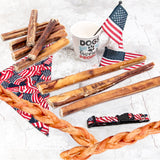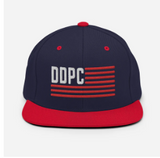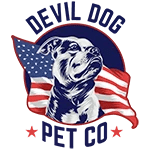Dog cologne is a specially formulated fragrance designed to keep your four-legged friend smelling fresh between baths without irritating their sensitive skin. Unlike human perfumes, quality dog cologne contains pet-safe ingredients that neutralize odors rather than just masking them with overpowering scents.
When our dog Dexter started developing that classic "dog smell" after his outdoor adventures, we discovered that the right cologne could extend the time between baths while keeping him smelling like something other than... well, wet dog.
Key Takeaways
- Dog cologne is formulated to keep dogs smelling fresh without irritating their sensitive skin.
- Unlike human perfumes, dog cologne uses pet-safe ingredients that neutralize odors instead of masking them.
- Using dog cologne can help extend the time between baths for your pet.
- The right dog cologne can prevent the typical "dog smell" after outdoor activities.
Table of Contents
- What Is Dog Cologne and Why Your Pup Might Need It
- Is Dog Cologne Safe for Dogs? The Unfiltered Truth
- Why Dog Cologne Deserves a Spot in Your Grooming Arsenal
- How to Choose the Right Dog Cologne: A No-Nonsense Guide
- Proper Application Techniques: Getting the Most from Your Dog Cologne
- DIY Dog Cologne: Craft Your Own Safe Scents
- Professional-Grade Dog Colognes: What Actually Works
- Common Dog Cologne Mistakes to Avoid
- Specialty Dog Colognes for Specific Situations
- Professional Grooming Insights: What the Experts Use
- When Cologne Isn't Enough: Addressing Persistent Odors
- Conclusion: Leading the Way to a Fresher Dog
Let's get something straight: dog cologne isn't just a luxury for show dogs or pampered pooches. It's a practical grooming tool that serves multiple purposes beyond the obvious freshness factor. The best dog colognes contain conditioning agents that nourish your dog's coat, antimicrobial ingredients that fight odor-causing bacteria, and safe scents that won't overwhelm your dog's sensitive nose.
As Marine Corps veterans, we appreciate straightforward solutions that actually work. Dog cologne isn't about making your dog smell like a perfume counter—it's about maintaining cleanliness, extending the time between stressful bath sessions, and strengthening your bond through positive grooming experiences.
Is Dog Cologne Safe for Dogs? The Unfiltered Truth

The question I hear most often from responsible owners is whether dog cologne is actually safe. The honest answer: it depends entirely on the product and your dog's individual sensitivities. Human cologne? Absolutely not. The alcohol content and synthetic fragrances in human products can irritate your dog's skin, trigger respiratory issues, and cause serious problems if ingested during grooming. For more on the risks associated with fragrances and pets, see this informative article on fragrance safety for dogs.
Quality dog cologne, however, is specifically formulated with canine safety in mind. The best products are:
- Alcohol-free to prevent skin irritation and drying
- pH-balanced for a dog's skin (which is different from human skin)
- Free from harsh chemicals, parabens, and artificial colors
- Formulated with natural deodorizers like baking soda or enzymes
- Scented with pet-safe essential oils or extracts
Even with "safe" ingredients, individual dogs may still have sensitivities. When we first tried cologne on Dexter, we did a patch test on a small area of his shoulder and waited 24 hours to check for any adverse reactions. This simple step can save you and your pup from unnecessary discomfort.
Warning Signs Your Dog Doesn't Tolerate Cologne
Pay attention to these red flags after applying dog cologne:
- Excessive scratching or licking at the application area
- Redness, bumps, or irritation on the skin
- Sneezing, coughing, or difficulty breathing
- Changes in behavior like restlessness or discomfort
- Eye watering or pawing at the face
If you notice any of these symptoms, immediately rinse the product off with warm water and mild soap, then consult your veterinarian. No scent is worth your dog's health and comfort.
Why Dog Cologne Deserves a Spot in Your Grooming Arsenal
Dog cologne isn't just about vanity—it offers practical benefits that improve both your life and your dog's well-being. Here's why we've made it part of our regular grooming routine:
Effective Odor Management Between Baths
Let's face it: dogs stink sometimes. Whether it's from rolling in something questionable, playing with other dogs, or just their natural oils, that distinctive dog smell can permeate your home. Quality dog cologne neutralizes these odors at the source rather than just covering them up, extending freshness between bath times.
When Dexter comes in from a muddy hike and a full bath isn't practical, a quick spray of dog cologne after a wipe-down keeps him smelling fresh without the full bathing ordeal. This is especially helpful for dogs who hate baths or have skin conditions that limit how often they should be shampooed. For more tips on keeping your dog clean and healthy, check out our guide to common pup parent mistakes that can impact hygiene and odor control.
Coat Conditioning and Maintenance
Premium dog colognes do double-duty by incorporating coat conditioners like aloe vera, vitamin E, or jojoba oil. These ingredients help maintain coat health, reduce static, and add a subtle shine. We've noticed Dexter's coat feels noticeably softer when we use a conditioning cologne regularly.
For dogs with longer coats, cologne can also help reduce tangles and make brushing easier. The light moisture from a quality spray helps the brush glide through the fur, reducing pulling and making grooming sessions more pleasant for everyone involved. If you’re looking for chews that help promote overall wellness alongside grooming, explore our premium elk antler dog chews—a natural way to support your dog’s dental and coat health.
The Psychological Benefits of Scent
There's a reason the grooming industry has embraced signature scents: they create positive associations. When your dog smells good, you're more likely to engage in physical contact like petting, cuddling, and play. This increased interaction strengthens your bond and improves your dog's emotional well-being.
Additionally, certain scents can have calming effects on dogs. Lavender-based colognes, for example, have been shown to reduce anxiety in some dogs during stressful situations like thunderstorms or car rides. While not a replacement for proper behavior training or anxiety management, the right scent can be part of a comprehensive approach to your dog's emotional health. If your pup struggles with anxiety during storms, our post on what to do when your dog is afraid of thunderstorms offers more calming strategies.
How to Choose the Right Dog Cologne: A No-Nonsense Guide

With hundreds of options flooding the market, finding the right dog cologne can feel overwhelming. Cut through the marketing hype with these straightforward selection criteria:
Ingredient Assessment: What to Seek and What to Avoid
First and foremost, check the ingredient list. Quality dog colognes have nothing to hide and will clearly list all ingredients. Look for:
- Natural deodorizers: Baking soda, zinc ricinoleate, or enzymatic compounds
- Coat conditioners: Aloe vera, vitamin E, oatmeal extract, or natural oils
- Safe scent sources: Plant extracts or essential oils (in appropriate dilutions)
Avoid products containing:
- Alcohol (especially SD alcohol or ethanol)
- Artificial colors (often listed as FD&C or D&C followed by a color and number)
- Parabens (methylparaben, propylparaben, etc.)
- Phthalates (often hidden in "fragrance" listings)
- Propylene glycol in high concentrations
Remember: fewer ingredients generally means fewer potential irritants. Simple formulations are often the safest choice, especially for dogs with sensitive skin. For a deeper dive into pet-safe fragrances and what to avoid, see this external resource: pet-safe fragrances guide.
Scent Selection: Finding the Right Balance
Dogs have approximately 300 million olfactory receptors compared to our measly 6 million. What smells pleasant to us might be overwhelming to them. Look for colognes with:
- Subtle, natural scents rather than strong, synthetic fragrances
- Scent profiles that dissipate gradually rather than lingering for days
- Options labeled as "light" or "gentle" for sensitive dogs
Popular dog-friendly scents include vanilla, lavender, chamomile, and light citrus notes. Avoid heavily floral or spicy scents that can be irritating. When we first started using cologne on Dexter, we chose a light vanilla scent and gradually introduced other options once we knew he tolerated them well.
Spray vs. Wipe vs. Foam: Choosing the Right Formulation
Dog colognes come in several formulations, each with pros and cons:
- Sprays: Most common and easiest to apply. Great for quick freshening but can startle noise-sensitive dogs. Avoid spraying directly on the face.
- Wipes: Pre-moistened with cologne solution. Good for targeted application and nervous dogs who fear spray bottles. Less economical for large dogs or frequent use.
- Foams: Pump into your hand and work through the coat. Provides more control and even distribution but takes longer to apply.
For Dexter, we found that sprays work best for his short coat, but we always spray our hands first and then rub the cologne into his fur rather than spraying directly. This prevents startling him and ensures even coverage without wetting his coat excessively.
The right dog cologne can be a game-changer in your grooming routine, keeping your pup fresh between baths while nurturing their skin and coat. By choosing products with safe, natural ingredients and appropriate scents, you'll enhance your dog's comfort while making those close cuddle sessions more pleasant for everyone involved. In our next installment, we'll dive deeper into application techniques, homemade alternatives, and our top product recommendations based on years of testing with our own four-legged testers.
Proper Application Techniques: Getting the Most from Your Dog Cologne
Even the highest-quality dog cologne won't do its job if applied incorrectly. After testing dozens of products on Dexter and working with countless dog owners, I've learned that application technique matters just as much as the product itself. Dog cologne isn't about dousing your pup in fragrance—it's about strategic application that maximizes benefits while minimizing potential irritation.
The Marine's Guide to Dog Cologne Application
Follow these field-tested steps for optimal results:
- Brush first: Always brush your dog thoroughly before applying cologne. This removes loose fur, dander, and surface dirt that can trap odors.
- Test your dog's reaction: Before full application, spray a small amount on your hand and let your dog sniff it. Watch for signs of discomfort or aversion.
- Spray your hands, not your dog: Instead of spraying directly on your dog, spray the cologne into your palms and then gently work it through your dog's coat. This prevents startling your dog and gives you more control over product distribution.
- Focus on odor zones: Concentrate on areas that typically develop odor: the back, chest, and base of tail. Avoid the face, genital areas, and any spots with cuts, scrapes, or skin issues.
- Less is more: Start with less than you think you need—2-3 spritzes for a medium-sized dog is plenty. You can always add more if needed, but removing excess product requires a bath.
- Allow drying time: Let the product dry completely before allowing your dog on furniture or bedding. This usually takes 3-5 minutes.
When we first started using cologne on Dexter, we made the rookie mistake of spraying directly onto his coat. He hated the cold mist and surprising sound. Switching to the hand-application method transformed his experience from stressful to enjoyable.
How Often Should You Use Dog Cologne?
Like all grooming products, dog cologne should be used judiciously. Overuse can lead to product buildup, skin irritation, and sensory overload for your dog. Here's a realistic frequency guide:
- Standard use: 1-2 times per week for normal activity levels
- Active dogs: After outdoor adventures or play sessions that leave them smelly
- Special occasions: Before guests arrive or social outings
- Sensitive skin: No more than once weekly, with extra attention to any skin reactions
Remember that cologne extends the time between baths—it doesn't replace them. If your dog smells bad enough that you're tempted to use cologne daily, it's time for a proper bath with dog-specific shampoo.
DIY Dog Cologne: Craft Your Own Safe Scents

Not finding the right commercial product? Creating your own dog cologne gives you complete control over ingredients while often saving money. After experimenting with various formulations for Dexter, we've landed on several reliable recipes that deliver freshness without compromising safety.
Basic Dog Cologne Recipe
This simple formula serves as an excellent starting point:
- 1 cup distilled water
- 2 tablespoons witch hazel (alcohol-free)
- 5-10 drops pet-safe essential oil (lavender, chamomile, or sweet orange work well)
- 1 teaspoon fractionated coconut oil (optional, for coat conditioning)
Combine ingredients in a clean spray bottle, shake well before each use, and apply as directed above. Store in a cool, dark place and use within 2-3 weeks, or refrigerate for up to a month.
Essential Oil Safety: Critical Knowledge
This bears repeating: not all essential oils are safe for dogs, and proper dilution is non-negotiable. Dogs metabolize compounds differently than humans do, and what's harmless to us can be toxic to them.
Safe essential oils for dogs (when properly diluted):
- Lavender (calming, gentle scent)
- Chamomile (soothing for skin)
- Cedarwood (natural insect repellent properties)
- Sweet orange (uplifting scent, deodorizing)
Essential oils to NEVER use on dogs:
- Tea tree (toxic to dogs even in small amounts)
- Cinnamon (skin and respiratory irritant)
- Pennyroyal (highly toxic)
- Wintergreen (contains compounds toxic to dogs)
- Ylang-ylang (too strong, potential irritant)
- Pine (can cause respiratory and liver issues)
When using essential oils, always dilute properly (no more than 5-10 drops per cup of base liquid), and observe your dog carefully after application. If you notice any adverse reactions, wash the product off immediately and consult your veterinarian. For additional insight into how odors and fragrances can affect pet health, visit this external resource on pet odor health risks.
Enhanced DIY Formulations for Specific Needs
Once you've mastered the basic recipe, try these specialized variations:
Odor-Neutralizing Blend
- 1 cup distilled water
- 2 tablespoons witch hazel (alcohol-free)
- 1 tablespoon apple cider vinegar
- 5 drops lavender essential oil
- 3 drops cedarwood essential oil
The apple cider vinegar helps neutralize odors naturally. Don't worry—the vinegar smell dissipates as it dries, leaving only the pleasant essential oil scent behind.
Soothing Formula for Sensitive Skin
- 1 cup chamomile tea (brewed strong and cooled)
- 1 tablespoon vegetable glycerin
- 1 teaspoon aloe vera gel (pure, without additives)
- 3 drops chamomile essential oil
This gentle formula is ideal for dogs with sensitive or irritated skin. The chamomile and aloe vera provide soothing benefits while adding a subtle, pleasant scent.
Professional-Grade Dog Colognes: What Actually Works
While DIY options are great for many situations, sometimes you need the reliability and convenience of a commercial product. After testing dozens of brands on dogs of all sizes and coat types, these are the options that consistently deliver results without compromising safety.
Top Dog Cologne Picks for Different Needs
Best Overall: Earthbath Spritz
Earthbath consistently delivers quality with their plant-derived ingredients and commitment to safety. Their Vanilla & Almond Spritz offers a subtle, gender-neutral scent that isn't overwhelming, while their conditioning ingredients leave coats soft and manageable. The spray is alcohol-free and contains no parabens, phosphates, or synthetic dyes.
Best for Sensitive Skin: TropiClean Spa Comfort Cologne
Formulated specifically for dogs with skin sensitivities, this oatmeal-infused cologne soothes while it freshens. The cucumber-melon scent is light enough not to overwhelm your dog's senses, and the alcohol-free formula won't dry out skin or cause irritation.
Best Long-Lasting: Bodhi Dog Natural Pet Cologne
When you need freshness that lasts through adventures, Bodhi Dog delivers impressive staying power without harsh chemicals. Their baby powder scent is subtle yet effective at neutralizing odors, and the spray contains natural deodorizers that continue working long after application.
Best Value: Wahl Doggie Deodorant
For budget-conscious owners who don't want to sacrifice quality, Wahl's deodorant spray offers excellent performance at a lower price point. The eucalyptus and spearmint formula refreshes without overwhelming, and the large bottle size means you get more applications per dollar.
Professional Application Tips
Even with premium products, technique matters. Professional groomers recommend:
- Storing cologne away from direct sunlight to preserve fragrance integrity
- Shaking thoroughly before each use to mix conditioning ingredients
- Applying immediately after towel-drying from a bath for maximum scent bonding
- Using cologne as a finishing touch after complete grooming, not as a substitute for cleaning
When Dexter comes back from training sessions or outdoor play, we've found that a quick brush followed by a light application of cologne keeps him fresh until his next scheduled bath. The key is consistency—regular light applications work better than occasional heavy ones.
Common Dog Cologne Mistakes to Avoid

Even with the best intentions, many owners make these critical errors when using dog cologne:
Overspraying: Less is Always More
The number one mistake is using too much product. Dogs have incredibly sensitive noses—what seems like a light scent to you can be overwhelming to them. Excessive application can also lead to:
- Product buildup that attracts dirt
- Skin irritation from prolonged contact
- Respiratory irritation from constant scent exposure
- Licking behavior as dogs try to remove the unfamiliar smell
Start with minimal application and increase gradually only if needed. Your dog should smell pleasantly fresh, not like they've been dipped in perfume.
Spraying the Face: A Dangerous Practice
Never spray cologne directly on your dog's face. Even pet-safe products can irritate eyes, nose, and mouth tissues. The startling sensation of spray near their face can also create negative associations with grooming.
If you want to freshen your dog's head area, spray cologne on a soft cloth and gently wipe the back of the neck and behind the ears, staying well away from the face.
Using Cologne as a Bath Substitute
Dog cologne extends the time between baths—it doesn't replace them. Relying solely on cologne without proper bathing eventually leads to skin issues, coat problems, and stronger odors as dirt and oils accumulate.
Establish a regular bathing schedule appropriate for your dog's breed, coat type, and activity level, using cologne as a refresher between washes rather than a replacement. To round out your at-home grooming skills, see our step-by-step post on how to trim your dog’s nails in three minutes—another key to a happy, fresh-smelling pup.
After years of trial and error with Dexter, we've found that the right dog cologne, properly applied, truly enhances the bond we share. There's something undeniably satisfying about a dog that not only looks clean but smells fresh too—especially when they're curled up next to you on the couch after a long day. In our final installment, we'll explore specialty colognes for specific situations, professional grooming insights, and how to address common odor problems that cologne alone can't fix.
Specialty Dog Colognes for Specific Situations
As a Marine, I learned that different missions require different equipment. The same principle applies to dog cologne. After years of testing products with Dexter and consulting with professional groomers, I've discovered that specific situations call for specialized formulations.
Event-Ready Colognes: When Impressions Matter
Whether you're heading to a dog-friendly restaurant or visiting relatives who aren't exactly "dog people," these premium options deliver next-level freshness:
- Warren London Cologne Spray: Their "Exquisite Pear" scent has impressive staying power without overwhelming. The conditioning formula adds shine to the coat while deodorizing.
- Nature's Miracle Supreme Odor Control Spray: Don't let the basic name fool you—this spray combines effective odor neutralizers with a sophisticated white flower scent that smells surprisingly upscale.
Before Dexter attends any family gatherings, we give him a thorough brushing followed by a light application of cologne. The difference in how guests interact with him is remarkable—people who normally keep their distance are much more likely to engage when he smells fresh.
Outdoor Adventure Formulas
Active dogs need specialized solutions that stand up to dirt, water, and outdoor elements:
- Particular Paws Deodorizing Spray: Contains natural enzymes that continue breaking down odor molecules even after your dog dries from swimming or hiking.
- Oster Fresh Breeze Cologne: The microencapsulated formula releases fresh scent gradually as your dog moves, making it ideal for extended outdoor activities.
For maximum effectiveness, apply these products after your dog has completely dried from their adventure. The formulations bond better to dry fur and create a longer-lasting barrier against new odors. If your pup is an outdoor enthusiast, you might also consider our collection of products for large and active dogs to keep them healthy and happy between baths.
Seasonal Scent Solutions
Different seasons bring different challenges for keeping your dog smelling fresh:
Summer Options
Hot weather intensifies dog odor and increases oil production. Look for lightweight, cooling formulas like:
- Espree Citrusil Plus Cologne: Contains citrus oils that naturally cut through summer funk while providing a cooling sensation.
- Bio-Groom Crisp Apple Cologne: The light, fruity scent counteracts summer mustiness without being heavy or cloying.
Winter Options
Indoor heating systems can dry out your dog's skin and coat in winter, creating different odor profiles:
- Isle of Dogs Coature No. 10 Evening Primrose Oil Cologne: Contains conditioning agents that prevent winter dryness while imparting a subtle, sophisticated scent.
- Gerrard Larriett Aromatherapy Freshening Spray: The lavender chamomile formula is perfect for winter months when your dog spends more time indoors on furniture and bedding.
After transitioning Dexter between these seasonal options, we've noticed significantly better odor control throughout the year. The right formula for the right season simply works better.
Professional Grooming Insights: What the Experts Use
To gain deeper understanding of dog cologne best practices, I interviewed five professional groomers with over 75 years of combined experience. Their insights reveal why professionals rely on certain products and techniques that most pet owners never discover.
Professional Secrets You Can Use at Home
These insider tips can dramatically improve your cologne application results:
- Layer scents strategically: Professional groomers often use matching shampoo and cologne lines to create a longer-lasting scent profile. The layered approach creates a foundation that helps the cologne adhere better.
- Apply to a slightly damp coat: While the coat should not be wet, applying cologne to a slightly damp coat (about 80% dry) helps distribute the scent more evenly.
- Focus on fabric contact points: Pay special attention to areas that will contact furniture and bedding—chest, sides, and haunches—as these transfer scent to your home.
- Use different scents for different purposes: Many professionals keep 2-3 cologne options on hand: a neutral daily scent, a stronger deodorizing formula for problem situations, and a premium scent for special occasions.
When we implemented these professional techniques with Dexter, we immediately noticed that his fresh scent lasted nearly twice as long. The layering approach, in particular, made a significant difference in scent longevity.
Groomer-Recommended Brands
These products rarely appear in retail stores but are staples in professional settings:
- Chris Christensen Just Divine Brushing Spray: Though marketed as a brushing aid, groomers often use this as a cologne for its subtle, clean scent and coat-conditioning properties.
- Davis Maximum Strength Cologne: Professional-strength formula that neutralizes even the strongest odors without overwhelming.
- ShowSeason Crisp 'N Clean: The industry standard for show dogs, delivering a neutral, fresh scent that doesn't interfere with the judge's assessment.
Many of these professional products are now available online, giving home groomers access to the same quality tools the professionals use.
When Cologne Isn't Enough: Addressing Persistent Odors
As much as we'd like a simple spray solution for all dog odors, some situations require more targeted intervention. If you're constantly reaching for the cologne bottle, you might be masking a problem that needs addressing.
Common Sources of Persistent Dog Odor
These issues won't respond to cologne alone:
- Dental problems: Bad breath often indicates dental disease that requires veterinary care, not masking with scents.
- Ear infections: A yeasty or musty smell around the head often points to ear issues that need medical treatment.
- Skin infections: Persistent "corn chip" or sour odors, especially with itching or redness, suggest yeast or bacterial skin infections.
- Anal gland issues: A fishy smell, particularly after your dog sits on furniture, often indicates anal gland problems.
- Seborrhea: Excessive oiliness with a strong, musty odor may indicate seborrheic dermatitis requiring medicated shampoo.
If you notice any of these specific odor patterns, schedule a veterinary visit instead of reaching for cologne. Addressing the root cause will improve your dog's health and comfort while eliminating the need for constant refreshing. You can also explore our broader Devil Dog Blog for more in-depth health and grooming articles.
Complementary Odor Control Strategies
For maximum freshness, combine cologne with these proven approaches:
- Regular brushing: Daily brushing removes dead hair, dander, and environmental debris before they can create odor.
- Proper nutrition: High-quality food with appropriate fat levels helps maintain healthy skin and coat, reducing odor at the source.
- Dental care routine: Daily tooth brushing or dental treats reduce oral bacteria that contribute to overall dog smell.
- Washing bedding weekly: Dog odor often comes from bedding rather than the dog itself. Wash beds and blankets in enzymatic cleaner to eliminate odor molecules.
- Air purification: HEPA filters with activated carbon can dramatically reduce pet odors in your home environment.
When we incorporated these strategies alongside occasional cologne use, Dexter's overall freshness improved dramatically. The comprehensive approach means we use less cologne while enjoying better results.
Conclusion: Leading the Way to a Fresher Dog
Choosing and using the right dog cologne exemplifies the Extreme Dog Leadership mindset—taking full responsibility for every aspect of your dog's presentation and well-being. By selecting safe, appropriate products and applying them correctly, you're not just masking odors; you're enhancing your relationship with your dog and creating a more pleasant environment for everyone.
Remember that dog cologne is just one tool in your grooming arsenal. The most effective approach combines occasional cologne use with consistent hygiene practices, proper veterinary care, and attention to your dog's individual needs. Take command of your dog's freshness with the same discipline and attention to detail you bring to training, nutrition, and exercise—your nose (and everyone else's) will thank you. And for more tips on celebrating your canine companion, don’t miss our post on celebrating your dog's birthday in style!
Download the FREE 10-Step Dog Prep Guide
Frequently Asked Questions
Is dog cologne safe for dogs?
Dog cologne can be safe if it’s specifically formulated for canine use with non-toxic, hypoallergenic ingredients. Avoid human perfumes or colognes, which may contain alcohol or chemicals that irritate your dog’s sensitive skin and nose. Always test a small area first and watch for any signs of discomfort or allergic reaction.
What can I spray on my dog to smell good?
Use dog-safe sprays like water-based colognes, grooming sprays, or essential oil blends diluted for pets. These products freshen your dog’s coat without harsh chemicals and often include skin-soothing ingredients. Avoid anything with artificial fragrances or alcohol that can dry out or irritate your pup’s skin.
What is the best scent for dogs?
Dogs prefer mild, natural scents that don’t overwhelm their sensitive noses. Light herbal or citrus-based fragrances, like lavender or chamomile, tend to be calming and well-tolerated. The best scent is one your dog doesn’t shy away from and that complements their natural smell without masking it aggressively.
Can I put a little cologne on my dog?
Only if it’s a dog-specific cologne designed with safe ingredients and applied sparingly. Human colognes should never be used on dogs because they can cause skin irritation and respiratory issues. When in doubt, stick to grooming products made for dogs and follow the recommended usage instructions.
What is the best dog deodorizer?
The best dog deodorizer is one that neutralizes odor without drying out skin or disrupting your dog’s natural oils. Look for sprays or wipes with natural enzymes or baking soda-based formulas that safely break down smells. Regular grooming, bathing with gentle shampoos, and good oral care are essential to keep your dog smelling fresh.
Can I use baby powder on my dog?
It’s generally not recommended to use baby powder on dogs, as many contain talc or fragrances that can irritate skin or be inhaled, posing respiratory risks. If you need to freshen your dog’s coat, opt for pet-safe powders made specifically for dogs. Always avoid getting powders near your dog’s nose, mouth, and eyes.






